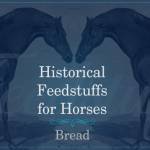Historical Feedstuffs for Horses: Horse-Bread

Long before commercial concentrates became commonplace, in a time when the basic diet of horses consisted of hay and oats, some high-performance horses, like those being prepared for racing, were given “horse-bread.”1 Chock-full of protein and calories, horse-bread was used to supplement diets, supposedly giving horses additional stamina for training and racing.
Published in many well-known horse management books written between 1600 and 1800, horse-bread recipes usually included peas, fava beans, and wheat flour.1,2 Peas and fava beans, both high in protein, were commonly grown in England and Europe at that time and were sometimes even called “horse beans.” The flour used was whole grain, thought to be mostly bran flour, which had a fiber content greater than present-day flours.
Horse-bread was not fed fresh out of the oven; in fact, authors warned against feeding it before it was three days old and dried out because it could cause stomach upset and “more apt to render a horse foggy.” In this context, foggy is thought to mean bloated or unhealthily fat.
In his Compleat Horseman, de Grey describes making and feeding horse-bread for racehorses in training:
“Grind three pecks of beans, with one peck of wheat into fine flour or meal…and made up with sweet yeast, and a little spring water, kneaded very painfully and throughly, and suffer it then to lie in the trough a space to rise and become light; then knead it again, and so make it into loaves, as big as sixpenny ones, and let them soak well in an oven; then taken out hot turn them upside down, and suffer them in that manner to cool.”2
“Three days after the baking, and not before for fear of surfeiting your horse, you may cut the bread in to thin shavings, and laying it a while to dry, put it amongst the oats crumbling it small, and give it your horse not exceeding more bread than a pound and a half at a time, the oats you mix it with being carefully sifted. This bait given in the morning first of all, you may about eleven of the clock give him another portion of bread and oats, not differing from the former.…”2
The idea of combining grain with a protein supplement started with horse-bread and eventually evolved into the first commercial feed, which was introduced near the beginning of the 20th century.
1de Grey, Thomas. 1684. The experienced jocky, compleat horseman; or gentlemans delight, containing plain and easie directions, in breeding, feeding, keeping and managing horses for all occasions, as war, racing, hunting, travel, &c. Printed for Will. Whitwood, next door to the Crown Tavern in Duck Lane, London.
2Gibson, William. 1741. The true method of dieting horses, the proper method of feeding suited to their age, strength and constitution ; wherein the pernicious customs, which have obtain’d among many ignorant grooms and other pretenders to horsemanship, are exposed, and their errors carefully amended. John Osborn and Tho. Longman, London.








